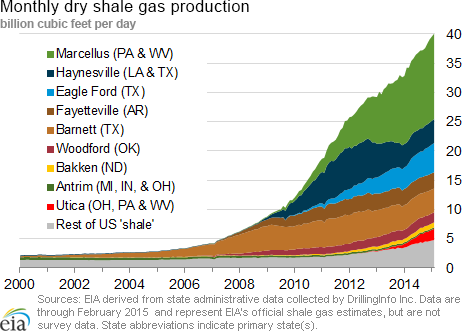In the News:
Cold temperatures, low prices lead to record-high winter power burn
Consumption of natural gas for electric power generation (power burn) in 2015 hit record levels earlier this year and has remained elevated through March, according to Bentek Energy data, averaging 22.7 billion cubic feet per day (Bcf/d) from January 1 through March 25. The increase in power burn has largely been the result of two factors: low natural gas prices and cold weather.
In many regions, natural gas competes with coal as a generation fuel, and recent relatively low natural gas prices have spurred more use of natural gas. Henry Hub spot prices have averaged $2.89/million British thermal unit (MMBtu) from January 1 through March 25, compared to $5.20/MMBtu last year. In addition to short-term changes, natural gas-fired generation capacity has become more prevalent in the United States, replacing older coal-fired and nuclear generation capacity. Cold temperatures this year have also supported higher demand from houses that heat with electricity. About one-third of U.S. households use electricity as their primary space heating fuel. The largest electricity space heating region is the South, but in many southern states more than half of households rely on electricity for heating.
Growth in power burn over the past 10 years has been particularly strong in the Southeast, which made up 35.6% of U.S. natural gas-fired generation during early 2015. Between January 1 and March 25 of this year, power burn in the Southeast averaged 8.1 billion cubic feet per day (Bcf/d), an increase of almost 2 Bcf/d from 2014, when prices were much higher, contributing to natural gas being less competitive with coal. The Northeast has also seen strong growth over the years, with power generation in the first three months of 2015 averaging 5.2 Bcf/d, an increase of 20% over last year.
In 2012, strong production and a warm winter led to an oversupply of natural gas and low prices. The power sector absorbed the extra natural gas on the market, and 2012 set the record for annual natural gas-fired power generation at 24.9 Bcf/d. The March Short-Term Energy Outlook projects 2015 electric power sector natural gas consumption will approach the 2012 level at 24.1 Bcf/d and will grow slightly in 2016.
Overview:
(For the Week Ending Wednesday, March 18, 2015)
- Natural gas prices remained relatively flat at most trading locations, with the exception of New England, through the report week (Wednesday to Wednesday). The Henry Hub spot price started the week at $2.77/million British thermal units (MMBtu) last Wednesday, and settled at $2.74/MMBtu yesterday. Trading locations in New England, as a result of unseasonably cold weather, began the report week above $11/MMBtu, but dropped toward $3.10/MMBtu by the Wednesday close.
- Price movements at the New York Mercantile Exchange (Nymex) were larger than movements in the spot market. The April contract started the week at $2.920/MMBtu last Wednesday, and settled down 20¢ to $2.723/MMBtu yesterday.
- Working natural gas in storage increased to 1,479 Bcf as of Friday, March 20, according to the U.S. Energy Information Administration (EIA) Weekly Natural Gas Storage Report (WNGSR). The first positive net injection this year, at 12 Bcf for the week, resulted in storage levels 63.6% above year-ago levels and 11.6% below the five-year average for this week.
- As of March 20, there were 1,069 total rigs operating in the United States, down 56 from the previous week. The natural gas rig count fell by 15 to 242, and the oil rig count fell by 41 to 825. Additionally, two miscellaneous rigs were in operation this week.
- The natural gas plant liquids composite price decreased 25¢ to $5.22/MMBtu, a loss of 4.6%, for the week ending March 20. All Mont Belvieu NGL spot prices, with the exception of ethane, fell this week. Natural gasoline prices decreased by 2.0%, propane fell 7.4%, butane was off 6.1%, and isobutane fell 7.6%. Ethane prices rose 0.7%.
Prices/Demand/Supply:
Outside of New England, prices at most locations remain flat with warmer temperatures. Natural gas prices at most trading locations remained at or near their report week start point, Wednesday to Wednesday, as seasonal temperatures held through the week. With the exception of New England, most locations stayed within 10¢ of their price last Wednesday through the report week. The Henry Hub spot price last Wednesday was $2.77/MMBtu and gained 5¢ through Friday, before dropping to end the week at $2.74/MMBtu.
Northeast prices move down as temperatures moderate. While Mid-Atlantic and New York area trading locations were at or below Henry Hub through the week, prices in New England remained higher. Prices at the Algonquin Citygate, which serves Boston, and at Tennessee Zone 6 200L, serving New England outside of Boston, started the week $11.91/MMBtu and 11.22/MMBtu, respectively. With moderating temperatures, prices at these locations declined later in the report week, but remained above Henry Hub. Yesterday, the Algonquin Citygate price settled to end the week at $3.19/MMBtu, and Tennessee Zone 6 200L closed at $3.07/MMBtu.
Prices in the Northeast, outside of New England, remained below $3/MMBtu throughout the week. At New York's Transcontinental Zone 6 (Transco Zone 6 NY), prices started the week last Wednesday at $2.83/MMBtu and closed the week at $2.54/MMBtu yesterday. Chicago Citygate in the Midwest also remained low, closing the report week at $2.74/MMBtu yesterday.
Marcellus-area prices trade down through the week. Prices at trading locations in the Marcellus area decreased overall this week, and Marcellus continues to be the lowest-priced trading area in the country. At Tennessee's Zone 4 trading point, which represents Marcellus deliveries on Tennessee's pipeline system, prices began the week at $1.47/MMBtu, dropped to $1.40/MMBtu on Friday, rose to $1.55/MMBtu on Monday, then slid lower to close at $1.22/MMBtu on Wednesday.
Prices on Transco's Leidy Line also ended the report week down from its starting price, declining 23¢, Wednesday to Wednesday, and closing at $1.31/MMBtu yesterday. Dominion South, which serves customers in portions of Pennsylvania, Ohio, Maryland, West Virginia, and Virginia, started the week higher than other Marcellus locations at $2.05/MMBtu, then fluctuated through the week to close the report week down 46¢ at $1.59/MMBtu.
Nymex prices decrease. At the Nymex, the near-month (April) contract fell this week from $2.920/MMBtu last Wednesday to $2.723/MMBtu. Reports of slowing natural gas withdrawals and the arrival of moderate seasonal temperatures, contributed to this decline. The 12-month strip (the average of the 12 contracts between April 2015 and March 2016) decreased from $3.033/MMBtu last Wednesday to $2.874/MMBtu yesterday.
Production increases, imports fall. Total natural gas supply increased 0.4% from last week with U.S. dry gas production posting a year-to-date high of 73.2 Bcf/d on Sunday and holding that level through Monday. This was largely because of record Northeast production which hit an all-time high of 19.9 Bcf/d, according to data from Bentek Energy. Dry gas production is 0.5% more than last week, and 8.8% greater than the same week last year. With temperatures holding close to normal levels across much of the country, imports of natural gas from Canada declined 0.4% from the previous week. Imports fell in all regions except the Northeast, where temperatures remained cool. Sendout of liquefied natural gas also declined from last week.
Consumption falls at the end of the report week. Over the report week, total domestic consumption showed large daily movements as temperatures shifted between above- and below-average. Seasonal, spring temperatures over the weekend, drove demand temporarily lower, with consumption rebounding on Monday, before falling significantly yesterday. For example, domestic consumption fell more than 10%, close to 10 Bcf/d, from Tuesday to yesterday. Overall, total domestic consumption grew 7.8% week-over-week, but was 2.9% less than the same week last year. Residential and commercial consumption drove most of this increase, with gains of 19.5% from last week. Industrial consumption increased as well, moving up by 1.2%. Nationally, power burn fell 0.5%, but there were modest regional increases in the Northeast, Southeast, and Texas. The largest of these was 4.5% seen in the Southeast.
Storage
The first net injection starts before the heating season ends in March. This is the first time since March 2012 that inventory builds started before the end of the heating season, traditionally defined as November 1 through March 31. Despite this, natural gas stocks remain below their five-year average. With a net injection of 12 Bcf for the week, working gas inventories as of March 20 totaled 1,479 Bcf, 575 Bcf (63.6%) higher than last year at this time and 194 Bcf (11.6%) lower than the five-year (2010-14) average. This year's net injection of 12 Bcf for the report week compares with the five-year average net withdrawal of 19 Bcf and last year's net withdrawal for the same week of 56 Bcf.
Storage injections are larger than market expectations. Market expectations, on average, called for a build of 6 Bcf. With the higher-than-expected injection, when the EIA storage report was released at 10:30 a.m. on March 26, the price for the April natural gas futures contract decreased a few cents to around $2.70/MMBtu in trading on the Nymex. In the next hour, prices declined further to around $2.66/MMBtu.
The East region is the only region to report net withdrawals for the week. With a 22-Bcf net storage withdrawal this week, the East region inventory is below its five-year average by 158 Bcf (22.0%). The deficit to their five-year average from facilities in the Producing region remains at 109 Bcf (15.9%). The West region is the only region above its five-year average. Storage levels for the East, West, and Producing regions are above their year-ago levels by 197 Bcf, 180 Bcf, and 198 Bcf, respectively.
Temperatures during the storage report week were warmer than normal. Temperatures in the Lower 48 states averaged 50.4° for the storage report week, 5.9° warmer than the 30-year normal temperature and 8.6° warmer than the average temperature during the same week last year. There were 109 population-weighted heating degree days during the storage report week, 1 fewer than the five-year average and 55 fewer than during the same period last year.
See also:
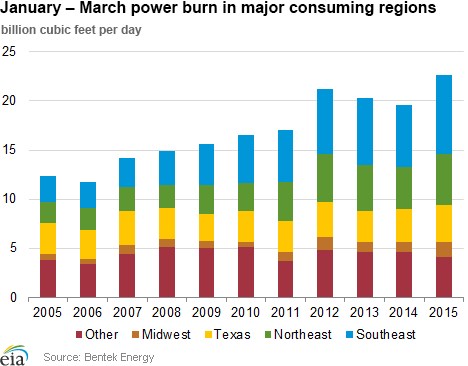
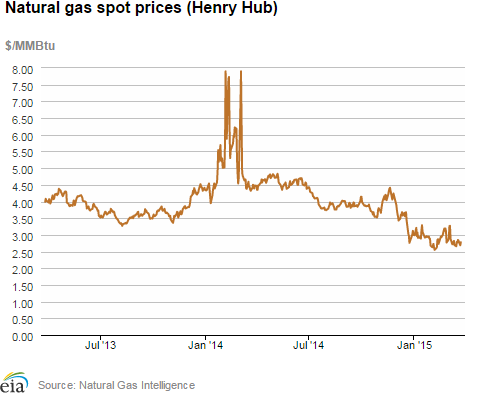
| Spot Prices ($/MMBtu) | Thu, 19-Mar |
Fri, 20-Mar |
Mon, 23-Mar |
Tue, 24-Mar |
Wed, 25-Mar |
|---|---|---|---|---|---|
| Henry Hub |
2.85 |
2.82 |
2.69 |
2.78 |
2.74 |
| New York |
2.84 |
2.89 |
2.78 |
2.69 |
2.54 |
| Chicago |
2.79 |
2.82 |
2.72 |
2.78 |
2.74 |
| Cal. Comp. Avg,* |
2.74 |
2.65 |
2.60 |
2.68 |
2.70 |
| Futures ($/MMBtu) | |||||
| April contract |
2.813 |
2.786 |
2.733 |
2.786 |
2.723 |
| May contract |
2.829 |
2.803 |
2.760 |
2.810 |
2.740 |
| *Avg. of NGI's reported prices for: Malin, PG&E citygate, and Southern California Border Avg. | |||||
| Source: NGI's Daily Gas Price Index | |||||
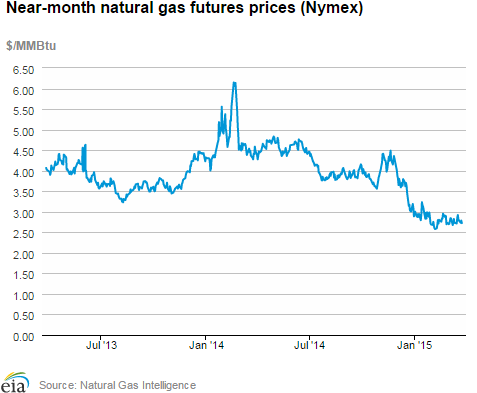
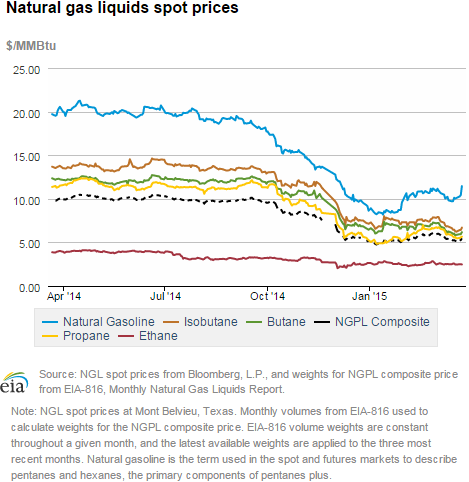
| U.S. natural gas supply - Gas Week: (3/18/15 - 3/25/15) | ||
|---|---|---|
Percent change for week compared with: |
||
last year |
last week |
|
| Gross production | 8.90%
|
0.52%
|
| Dry production | 8.82%
|
0.52%
|
| Canadian imports | 17.90%
|
-0.42%
|
| West (net) | 40.56%
|
-5.44%
|
| Midwest (net) | -32.74%
|
-13.04%
|
| Northeast (net) | 61.82%
|
31.96%
|
| LNG imports | -21.52%
|
-45.23%
|
| Total supply | 9.34%
|
0.35%
|
| Source: BENTEK Energy LLC | ||
| U.S. consumption - Gas Week: (3/18/15 - 3/25/15) | ||
|---|---|---|
Percent change for week compared with: |
||
last year |
last week |
|
| U.S. consumption | -2.9%
|
7.8%
|
| Power | 14.9%
|
-0.5%
|
| Industrial | -3.7%
|
1.2%
|
| Residential/commercial | -11.6%
|
19.5%
|
| Total demand | -2.5%
|
7.7%
|
| Source: BENTEK Energy LLC | ||
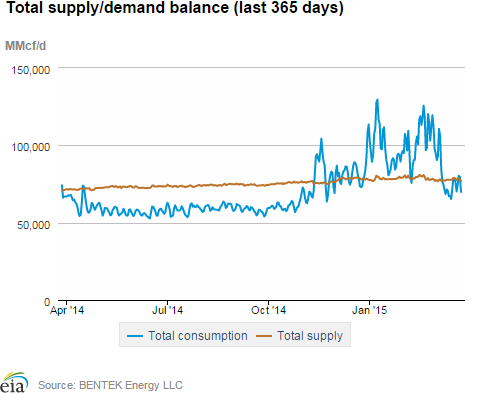
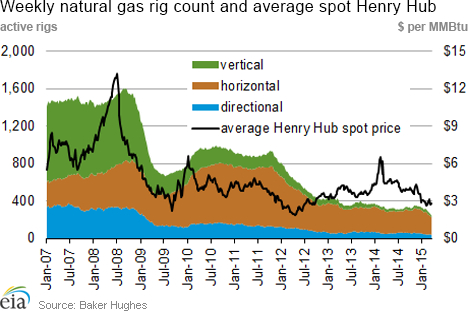
| Rigs | |||
|---|---|---|---|
Fri, March 20, 2015 |
Change from |
||
last week |
last year |
||
| Oil rigs | 825 |
-4.73% |
-43.99% |
| Natural gas rigs | 242 |
-5.84% |
-25.77% |
| Miscellaneous | 2 |
0.00% |
-50.00% |
| Rig numbers by type | |||
|---|---|---|---|
Fri, March 20, 2015 |
Change from |
||
last week |
last year |
||
| Vertical | 148 |
-10.84% |
-61.46% |
| Horizontal | 829 |
-2.36% |
-31.26% |
| Directional | 92 |
-16.36% |
-56.81% |
| Source: Baker Hughes Inc. | |||
| Working gas in underground storage | ||||
|---|---|---|---|---|
Stocks billion cubic feet (bcf) |
||||
| Region | 2015-03-20 |
2015-03-13 |
change |
|
| East | 559 |
581 |
-22 |
|
| West | 344 |
338 |
6 |
|
| Producing | 576 |
548 |
28 |
|
| Total | 1,479 |
1,467 |
12 |
|
| Source: U.S. Energy Information Administration | ||||
| Working gas in underground storage | |||||
|---|---|---|---|---|---|
Historical comparisons |
|||||
Year ago (3/20/14) |
5-year average (2010-2014) |
||||
| Region | Stocks (Bcf) |
% change |
Stocks (Bcf) |
% change |
|
| East | 362 |
54.4 |
717 |
-22.0 |
|
| West | 164 |
109.8 |
270 |
27.4 |
|
| Producing | 378 |
52.4 |
685 |
-15.9 |
|
| Total | 904 |
63.6 |
1,673 |
-11.6 |
|
| Source: U.S. Energy Information Administration | |||||
| Temperature -- heating & cooling degree days (week ending Mar 19) | ||||||||
|---|---|---|---|---|---|---|---|---|
HDD deviation from: |
CDD deviation from: |
|||||||
| Region | HDD Current |
normal |
last year |
CDD Current |
normal |
last year |
||
| New England | 230
|
29
|
-30
|
0
|
0
|
0
|
||
| Middle Atlantic | 195
|
9
|
-44
|
0
|
0
|
0
|
||
| E N Central | 152
|
-44
|
-86
|
0
|
0
|
0
|
||
| W N Central | 126
|
-69
|
-70
|
0
|
-1
|
0
|
||
| South Atlantic | 86
|
-24
|
-64
|
21
|
10
|
13
|
||
| E S Central | 64
|
-39
|
-59
|
1
|
-4
|
1
|
||
| W S Central | 36
|
-26
|
-35
|
15
|
3
|
12
|
||
| Mountain | 90
|
-67
|
-47
|
7
|
5
|
5
|
||
| Pacific | 21
|
-68
|
-27
|
5
|
4
|
5
|
||
| United States | 109
|
-38
|
-55
|
7
|
3
|
5
|
||
|
Note: HDD = heating degree-day; CDD = cooling degree-day Source: National Oceanic and Atmospheric Administration | ||||||||
Average temperature (°F)
7-Day Mean ending Mar 19, 2015
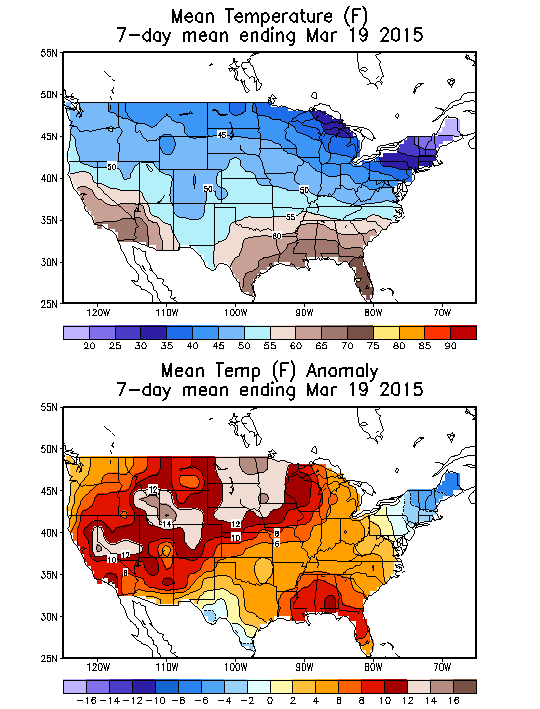
Source: NOAA/National Weather Service
Deviation between average and normal (°F)
7-Day Mean ending Mar 19, 2015

Source: NOAA/National Weather Service

